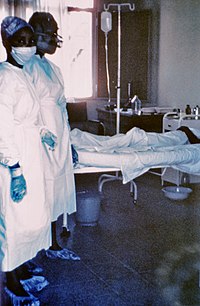
Photo from wikipedia
Zaire Ebola virus (EBOV) infection causes a severe and often fatal disease characterized by inflammation, coagulation defects, and organ failure driven by a defective host immune response. Lymphoid tissues are… Click to show full abstract
Zaire Ebola virus (EBOV) infection causes a severe and often fatal disease characterized by inflammation, coagulation defects, and organ failure driven by a defective host immune response. Lymphoid tissues are key sites of EBOV pathogenesis and the generation of an effective immune response to infection. ABSTRACT Infection with Zaire ebolavirus (EBOV), a member of the Filoviridae family, causes a disease characterized by high levels of viremia, aberrant inflammation, coagulopathy, and lymphopenia. EBOV initially replicates in lymphoid tissues and disseminates via dendritic cells (DCs) and monocytes to liver, spleen, adrenal gland, and other secondary organs. EBOV protein VP35 is a critical immune evasion factor that inhibits type I interferon signaling and DC maturation. Nonhuman primates (NHPs) immunized with a high dose (5 × 105 PFU) of recombinant EBOV containing a mutated VP35 (VP35m) are protected from challenge with wild-type EBOV (wtEBOV). This protection is accompanied by a transcriptional response in the peripheral blood reflecting a regulated innate immune response and a robust induction of adaptive immune genes. However, the host transcriptional response to VP35m in lymphoid tissues has not been evaluated. Therefore, we conducted a transcriptional analysis of axillary and inguinal lymph nodes and spleen tissues of NHPs infected with a low dose (2 × 104 PFU) of VP35m and then back-challenged with a lethal dose of wtEBOV. VP35m induced early transcriptional responses in lymphoid tissues that are distinct from those observed in wtEBOV challenge. Specifically, we detected robust antiviral innate and adaptive responses and fewer transcriptional changes in genes with roles in angiogenesis, apoptosis, and inflammation. Two of three macaques survived wtEBOV back-challenge, with only the nonsurvivor displaying a transcriptional response reflecting Ebola virus disease. These data suggest that VP35 is a key modulator of early host responses in lymphoid tissues, thereby regulating disease progression and severity following EBOV challenge. IMPORTANCE Zaire Ebola virus (EBOV) infection causes a severe and often fatal disease characterized by inflammation, coagulation defects, and organ failure driven by a defective host immune response. Lymphoid tissues are key sites of EBOV pathogenesis and the generation of an effective immune response to infection. A recent study demonstrated that infection with an EBOV encoding a mutant VP35, a viral protein that antagonizes host immunity, can protect nonhuman primates (NHPs) against lethal EBOV challenge. However, no studies have examined the response to this mutant EBOV in lymphoid tissues. Here, we characterize gene expression in lymphoid tissues from NHPs challenged with the mutant EBOV and subsequently with wild-type EBOV to identify signatures of a protective host response. Our findings are critical for elucidating viral pathogenesis, mechanisms of host antagonism, and the role of lymphoid organs in protective responses to EBOV to improve the development of antivirals and vaccines against EBOV.
Journal Title: Journal of Virology
Year Published: 2021
Link to full text (if available)
Share on Social Media: Sign Up to like & get
recommendations!